What is a Biological Hazard?
Biological hazards, also known as biohazards, refer to biological substances that threaten the health of living organisms. These substances can come in various forms, potentially harming humans, animals, or the environment.
Biohazards can be derived from various sources, such as bacteria, viruses, fungi, parasites, prions, biological toxins, and other pathogenic microorganisms. Depending on the type and severity of exposure, they may cause infectious diseases, allergic reactions, or other health problems.
These hazards can occur naturally, such as in the case of infectious diseases, or they can result from human activities, such as laboratory work or bioengineering. Biological hazards can be found in various settings, including healthcare facilities, laboratories, animal handling environments, and waste disposal sites.
The risks associated with biological hazards depend on several factors, such as the type of biological agent, the degree of exposure, and the vulnerability of the person exposed. For example, individuals with weakened immune systems may be more susceptible to infection than others. Some biological agents can also cause severe diseases or health issues, while others may only cause mild symptoms.
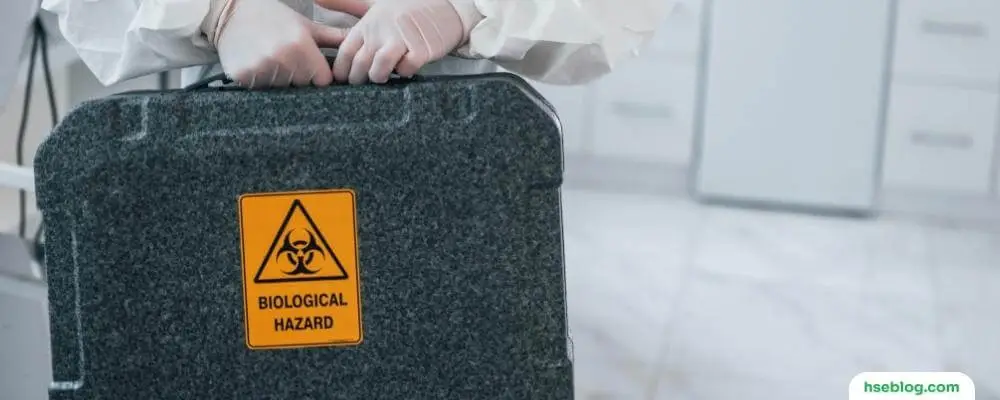
10 Biological Hazard Examples
In diverse workplaces and industries, a variety of biohazards pose significant threats to the well-being and safety of employees. Digging deeper into each, here are ten instances of biological hazards that your workforce may potentially encounter.
1. Human Blood and Blood Products
Human blood and its products, such as serum, plasma, and other blood components, can pose a serious biological hazard due to their potential to carry infectious pathogens. Notable among these are the viruses responsible for Human Immunodeficiency Virus (HIV), Hepatitis B, and Hepatitis C. These pathogens can lead to severe, sometimes life-threatening diseases.
Exposure can occur in numerous ways, such as skin puncture by contaminated needles, direct contact with broken skin or mucous membranes, or accidental ingestion or inhalation. The risk of infection from these exposures varies and depends on factors like the type and concentration of the pathogen, the volume of blood involved, the exposure route, and the individual’s immune status.
2. Animal Waste
Animal waste, encompassing excreta, discarded animal parts, or bedding material, can harbor various pathogens, such as bacteria, viruses, and parasites. Microorganisms present in animal waste, including Salmonella, E. coli, and various parasites, can lead to human diseases, ranging from gastrointestinal issues to more severe conditions.
People working in close contacts with animals or their waste, such as those in farming, veterinary practice, or pet retail, face higher exposure risks. Ingestion or inhalation of these pathogens, or even direct skin contact, can lead to infection. Therefore, handling and disposal of animal waste are critical in these environments to minimize disease transmission.
3. Human Bodily Matter
Human bodily matter, encompassing blood, saliva, urine, and mucus, can carry numerous pathogens, including viruses, bacteria, fungi, and parasites. These pathogens can cause illnesses from common colds and influenza to more severe diseases like hepatitis or HIV. Healthcare workers are particularly susceptible due to routine exposure to such matters during patient care.
The routes of infection can be diverse, including direct contact with broken skin or mucous membranes, inhalation of aerosols, or accidental ingestion. Hence, in healthcare and laboratory settings, stringent protocols for the handling and disposing of human bodily matter are necessary to prevent the spread of infections.
4. Microbiological Waste
Microbiological waste, originating from research, clinical, or diagnostic laboratories, refers to discarded cultures, stocks, or specimens of infectious agents that may harbor high concentrations of pathogens. Such waste can include bacteria, viruses, fungi, prions, and parasites used for research or diagnostic testing. Due to their close contact with these materials, lab workers face an elevated exposure risk.
Mismanagement of this waste can lead to contamination and the potential for accidental release of these pathogens into the environment, posing a significant risk to public and environmental health. Thus, microbiological waste requires stringent handling, treatment, and disposal procedures, often involving autoclaving, incineration, or other approved decontamination methods, to neutralize the risk before disposal.
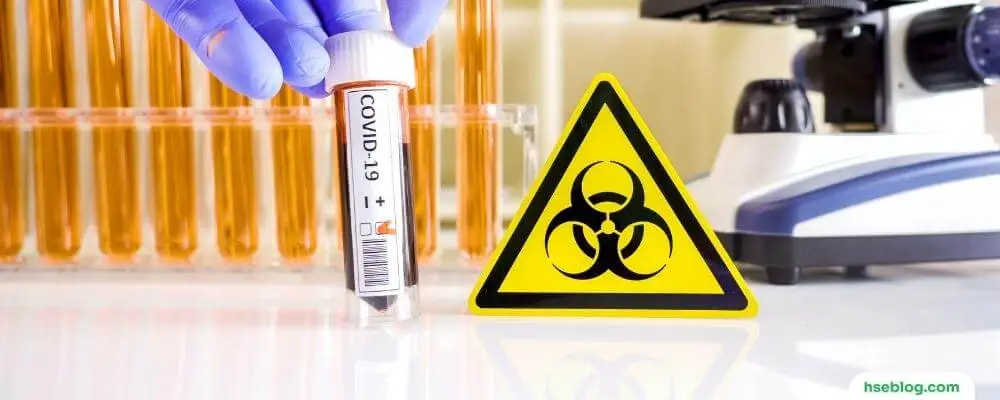
5. Pathological Waste
Pathological waste is discarded human tissues, organs, or body parts resulting from surgical procedures or autopsies. Given their biological origin, these waste materials can potentially harbor many pathogens, including bacteria, viruses, or prions, which may cause infectious diseases. The risk of exposure to these pathogens is heightened for healthcare professionals, such as surgeons, nurses, and mortuary staff, who regularly interact with such waste in their line of work.
Pathological waste can pose a direct infection risk via contact transmission or indirectly by contaminating surfaces and instruments. Therefore, handling, storing, and disposing of this waste must be handled using stringent safety protocols, including appropriate personal protective equipment (PPE), secure containers for transportation, and approved treatment methods before final disposal.
6. Sharps Waste
Sharps waste, an important category of biomedical waste, consists of objects that can puncture or lacerate the skin, including but not limited to needles, scalpels, lancets, broken glass, and even certain types of plastic. When contaminated with blood or other bodily fluids, these items can pose a serious health risk as they can potentially transmit bloodborne pathogens, such as HIV, hepatitis B and C, and others. If these contaminated sharps accidentally pierce the skin, the pathogens can directly enter the bloodstream, leading to infection. This is a particular concern in healthcare and laboratory environments, where the usage of sharps is common.
As such, the correct management and disposal of sharps waste are critically important. This includes using puncture-resistant containers for disposal, careful handling to avoid accidental injuries, regular training of staff on proper procedures, and in some cases, the use of safety-engineered devices to prevent needle-stick injuries.
7. Molds and Yeasts
Molds and yeasts, two common types of fungi, can pose various health risks to individuals. When inhaled or when they come into contact with the skin, they can trigger allergic reactions in sensitive individuals, leading to symptoms such as sneezing, coughing, itchy eyes, and skin rashes.
Additionally, certain molds and yeasts can potentially cause infections in people with weakened immune systems. Moreover, some molds produce toxic substances known as mycotoxins, which can result in toxic responses when ingested or when in contact with the skin. These fungi thrive in environments with high moisture levels and poor ventilation, making damp buildings, basements, and areas with water damage susceptible to mold and yeast growth.
The presence of molds and yeasts in indoor environments can significantly impact air quality, leading to respiratory issues and other health concerns. Proper moisture control, ventilation, and prompt remediation of water damage are essential in preventing and addressing mold and yeast-related issues to safeguard the health of occupants.
8. Organic Material
Organic material encompasses many substances, including garbage, wastewater, sewage, plant materials, and organic dust, which can harbor diverse microorganisms. These microorganisms may include bacteria, viruses, fungi, and parasites, some of which can be pathogenic to humans. Workers who handle or come into contact with organic material, such as sanitation workers, wastewater treatment plant employees, agricultural workers, and waste management personnel, are at an increased risk of exposure to these microorganisms.
Depending on the specific pathogens present, exposure to organic material can lead to various bacterial, viral, and parasitic diseases, ranging from gastrointestinal infections to respiratory illnesses. It is crucial for workers in these industries to follow appropriate hygiene practices, wears personal protective equipment, and receive proper training to minimize the risk of infection associated with handling organic material. Regular monitoring, risk assessments, and implementation of control measures are also necessary to safeguard the health and well-being of workers in these occupations.
9. Airborne Pathogens
Airborne pathogens refer to infectious microorganisms, including viruses, bacteria, and other microbes, that can be transmitted through the air. These pathogens can cause respiratory infections and diseases in humans. Transmission occurs when infected individuals release respiratory droplets or aerosols into the air through coughing, sneezing, or talking. The droplets or aerosols can contain pathogenic microorganisms and can be inhaled by people near the infected individual.
Examples of airborne pathogens include the influenza virus, tuberculosis bacteria, and the SARS-CoV-2 virus responsible for COVID-19. The risk of transmission is particularly heightened in enclosed spaces with poor ventilation, as it allows the concentration of infectious particles to build up over time. Preventive measures such as proper ventilation, wearing masks, maintaining physical distance, and practicing good respiratory hygiene are crucial in reducing the spread of airborne pathogens and protecting individuals from respiratory infections.
10. Stinging Insects
Stinging insects, including bees, wasps, hornets, and certain spiders, present a hazard to workers, especially those engaged in outdoor activities. While the primary concern is physical injury from their stingers, these insects can also introduce venom into the body, leading to various reactions. For individuals with allergies, stings can trigger severe and potentially life-threatening allergic reactions, known as anaphylaxis. Symptoms may include difficulty breathing, swelling of the throat or tongue, rapid heartbeat, dizziness, and loss of consciousness.
Prompt medical attention is crucial in such cases. Even without allergies, repeated or multiple stings can cause pain, swelling, and local reactions. Agriculture, landscaping, construction, and outdoor recreation workers are particularly susceptible to stings. Implementing preventive measures, such as wearing protective clothing, using insect repellents, and receiving appropriate training on identifying and responding to stinging insect encounters, can help mitigate the risks associated with these hazards.
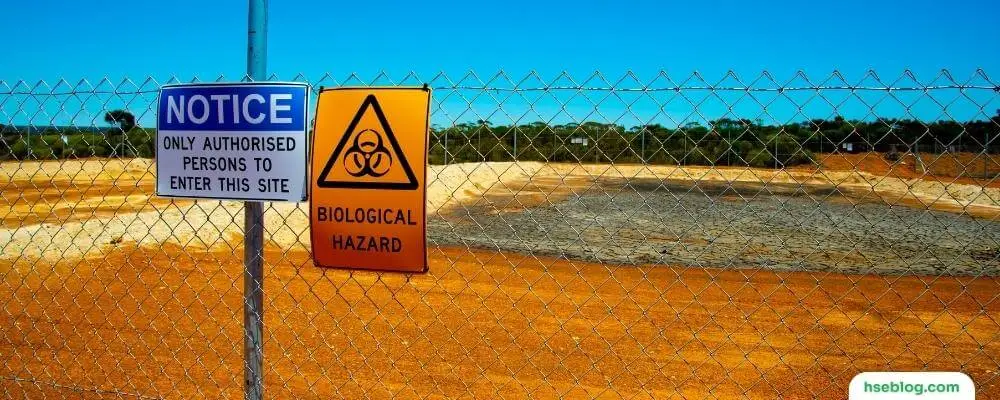
Biohazard Safety Levels
The Centers for Disease Control and Prevention (CDC) has established four biosafety levels (BSLs) to guide the safe handling and containment of microbes and biological agents. Each level has specific controls and precautions in place:
Biohazard Level 1 (BSL-1)
This level involves working with agents that pose minimal risk to humans and the environment. Examples include non-infectious bacteria and viruses, such as certain strains of E. coli. BSL-1 laboratories require basic safety practices, including hand hygiene, proper waste disposal, and personal protective equipment (PPE) like face masks.
Biohazard Level 2 (BSL-2)
BSL-2 covers agents that pose moderate hazards to humans and can be transmitted through direct contact. Examples include pathogens like HIV, hepatitis B, and Salmonella. BSL-2 laboratories require additional precautions such as access controls, proper waste management, containment equipment, and training on handling potentially infectious materials.
Biohazard Level 3 (BSL-3)
BSL-3 involves working with airborne pathogens that can cause serious or potentially lethal human diseases. These pathogens are often transmitted through respiratory routes. Tuberculosis-causing bacteria (Mycobacterium tuberculosis) is an example of a BSL-3 agent. BSL-3 laboratories have stringent engineering controls, such as specialized ventilation systems, and require extensive PPE usage, including respiratory protection.
Biohazard Level 4 (BSL-4)
BSL-4 is the highest containment level and involves working with highly dangerous pathogens that can cause life-threatening diseases. Examples include the Ebola virus and the Lassa virus. BSL-4 laboratories require maximum security and protection measures, including complete isolation, airlock entry systems, full-body protective suits, and stringent decontamination procedures.
Each biosafety level has specific requirements for laboratory design, PPE usage, biosafety equipment, and protocols. Adherence to Standard Microbiological Practices is essential at all BSLs. It is important to categorize the 10 biological hazard examples mentioned earlier according to their potential risks and assign them to the appropriate BSL to ensure proper containment and safety measures. Conducting thorough job hazard analyses and risk assessments is crucial to establish safe operating procedures aligned with the specific biosafety levels.
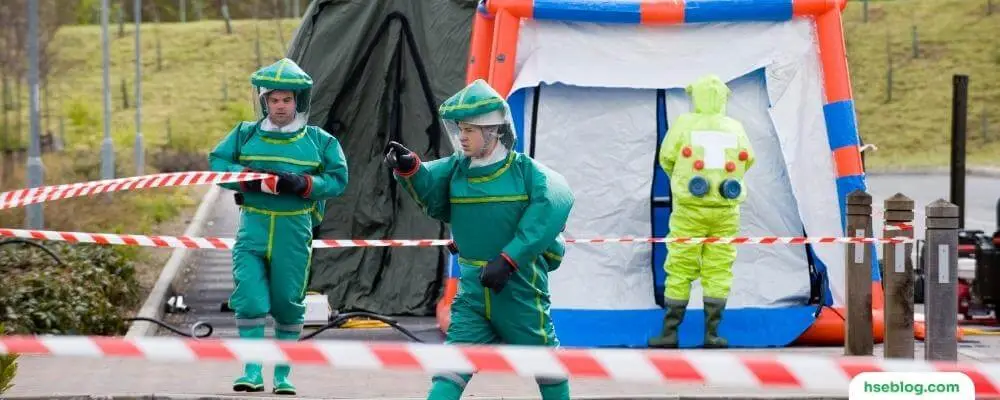
Regulations
In the United Kingdom, the Control of Substances Hazardous to Health Regulations 2002 (COSHH) is the primary legislation that applies to biohazards. This regulation, established by the UK Health and Safety Executive (HSE), sets out the responsibilities of employers in safeguarding the health and safety of workers and others from the hazards associated with substances.
Under COSHH, employers must take several key steps to protect against biohazards.
- First and foremost, they must identify the present and potential hazards associated with substances in the workplace. This involves assessing the risks through comprehensive risk assessments to understand the potential harm to health.
- Based on the risk assessments, employers must implement appropriate control measures to minimize or eliminate health risks. This may include engineering controls, safe work practices, personal protective equipment (PPE) use, and proper storage and handling procedures.
- To ensure ongoing safety, employers must maintain control measures in good working order and regularly review and update them as necessary. They must also provide employees relevant information, instruction, and training regarding the hazards and control measures associated with biohazards.
- Monitoring and health surveillance may be required in certain situations to detect and monitor any adverse health effects related to biohazards. This can involve regular health checks, biological monitoring, and environmental monitoring.
- Additionally, employers must establish emergency action plans to effectively respond to biohazard incidents or outbreaks. These plans should outline the procedures to be followed, communication protocols, and the provision of necessary resources to manage emergency situations.
By adhering to COSHH regulations and fulfilling these requirements, employers can create a safer work environment, protect employees’ health, and minimize the risks posed by biohazards.
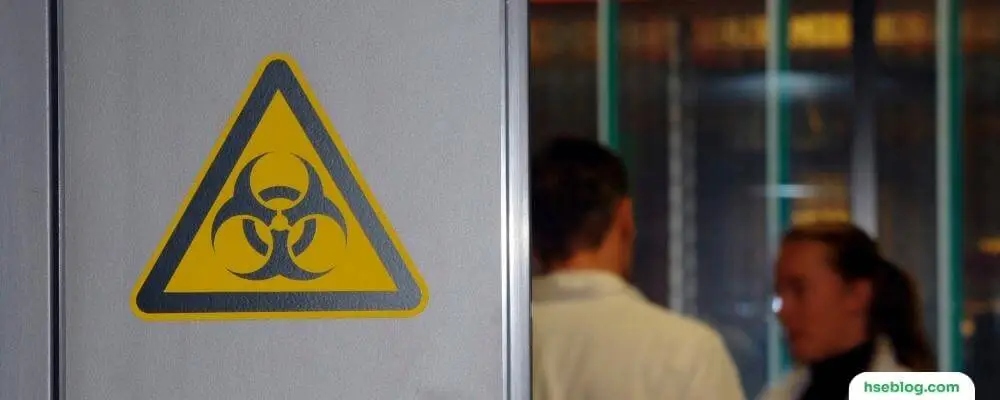
Biological Hazard Inspection Checklists
Biological hazard inspection checklists can be valuable tools for assessing and identifying potential biohazards in a workplace or environment. While specific checklists may vary depending on the industry and setting, here are some key areas to consider when developing a biological hazard inspection checklist:
Personal Protective Equipment (PPE):
Biological Waste Management:
Containment and Safety Measures:
Cleaning and Decontamination:
Training and Education:
Emergency Response:
Compliance with Regulations:
It’s important to customize the checklist to the specific requirements and risks of the workplace or environment. Regular inspections using the checklist can help identify areas for improvement, ensure adherence to safety protocols, and mitigate potential biohazard risks.
Conclusion
Biological hazards are a reality that we encounter in various aspects of our lives, whether it be in the workplace, the environment, or even within our own bodies. Understanding the nature of these hazards and implementing effective control measures is crucial for protecting ourselves and others from potential harm. Throughout this article, we have explored the definition of biological hazards, examined common examples ranging from bloodborne pathogens to stinging insects, and discussed important control measures such as proper waste management, personal protective equipment, and education and training.
By identifying and assessing the risks associated with biological hazards, we can develop comprehensive strategies to mitigate their impact. Employers, employees, and individuals must take responsibility for creating safe environments by adhering to regulations, practicing good hygiene, and implementing preventive measures. Regular risk assessments, training programs, and ongoing monitoring can further enhance our ability to detect and address potential biohazard risks.
Staying informed and proactive is crucial as we continue to navigate a world shaped by evolving biological threats. By working together and prioritizing the well-being of ourselves and others, we can effectively manage biological hazards and ensure the health and safety of our communities. Let us embrace a culture of awareness, preparedness, and responsible action to combat the challenges posed by biological hazards, ultimately fostering a healthier and more secure future for all.

